
 |
The Internet's Largest and Fastest Growing Engraving Community
Discuss hand engraving using basic to the most advanced methods and equipment
Forum Members: 14,762. Welcome to our newest member, Katherine
EngravingForum.com -
Domain since Feb 7, 2003
 Graver Video Conferencing is empty Join now!
Graver Video Conferencing is empty Join now!
|
|||||||
| ENGRAVING TOOLS - Paypal accepted | Classes | Glossary | Feedback | Tips | Sharpening | Bulino | Videos | Forum Policies |
 |
|
|
Thread Tools |
|
#1
|
||||
|
||||
|
This is a draft of an article that appeared in the Nov/Dec issue of Shooting Sportsman magazine. I thought the members of this forum may find it interesting.
The Engravers of Val Trompia Photos and text copyright 2006 by Barry Lee Hands As an Engraver I always have been fascinated by the different styles of practitioners of the Art. I have taken every opportunity to examine the ornamental design and techniques of those who came before me. From my early studies in the 1970's under Ethan Jacczak at Gist Engravers on the west coast, Into the 80’s Under Steve Huff, and Dan Goodwin in Montana. Then in my work with the Colt and Winchester Custom shops, and my recent studies under Ron Smith and Winston Churchill, these Artists have Instilled me with a respect for, and study of, Old World engravers. So how could I resist when, at the 2004 EWA show in Nuremburg, engraver Stephano Pedretti invited me to visit his studio in Italy's Val Trompia? Anyone who knows anything about engraving knows that the Val Trompia region because of the high concentration of Gunmakers is a Mecca for engravers, with the world’s largest group of talented professionals. In this small mountain village are the studios of Creative Arts, Pedretti, Fracassi, Pedersoli, Torcoli, Sabbati and many others, and the best training for the next generation in apprenticeships and Schools such as Giovanelli's. It was only a month later that I arrived at the Hotel Albergo Marcheno in Brescia, with my duffle bag, my camera and laptop computer. My plan was to meet, interview and observe as many craftsman as I could in the short time that I had in the area. Needless to say, I hit the ground running. I had no more than checked into my room and thrown my bags on the bed when I headed down Via Independenza toward the gunmaking center. I had walked only 200 yards when I came upon Fausti Stephano, Gunmakers. The company is unusual in the trade in that besides making a complete line of shotguns, the firm is operated by three sisters. Father Stefano started the business, and when the time came for him to retire, he passed the operation to his three children. 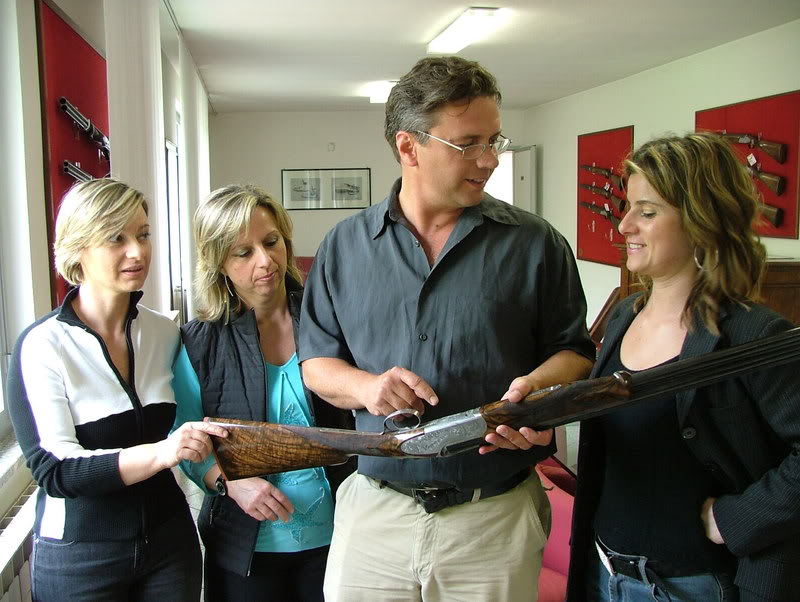 Barbara Fausti explained the product line and showed me their new gun, the "Vittoria Alata"and offered to take me to the Giovanelli engraving school in the morning. The next day we met at Fausti and drove up the hill to the Giovanelli School. There I was greeted by Elena Micheli and met Mr. Cesare Giovanelli, the founder of the school. Elena does a lot of work as liaison between American and Italian gunmakers and Engravers in her work as an interpreter. I was then introduced to Dario Cortini, the Master Engraver, and he showed me around the engraving room. I met Mary Giovanelli, Tiziana Rinaldini, Tiziano Baresi and Fabio Pasotti. 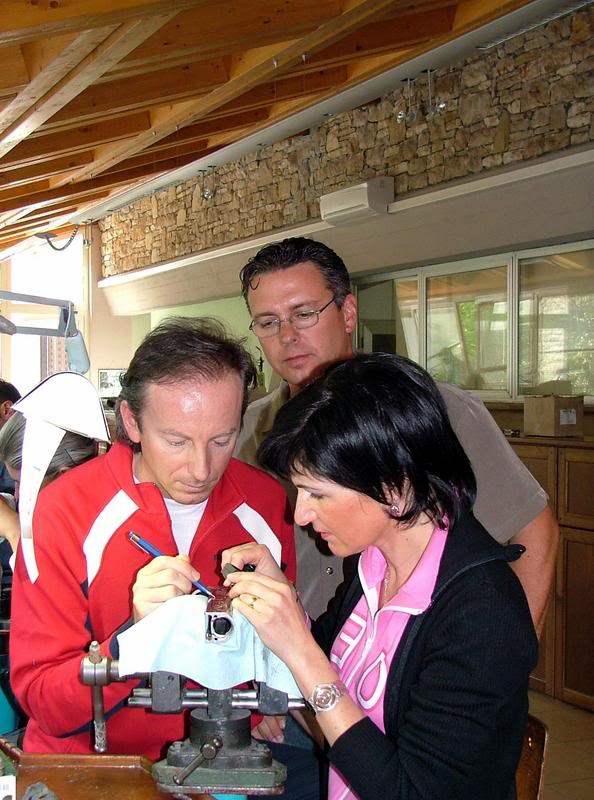 Most of the students are from Italy and study five days a week for one year. Some stay for longer periods and work for the company. The Master and students were interacting in a very creative environment. Some students were working on Bulino figures, learning the classic Italian technique that gives such stunning photographic realism and unparalleled beauty to the best work of Italy. Bulino style is named after the tool which is used to execute it, a small sharp v shaped chisel which fits in the palm. Tiny cuts the size of a pinpoint are made. Under high magnification each cut by a Master is often in the outline of a small diamond, or Rhombus when viewed by itself on the steels. A beginner, on the other hand, lacking the skills to cut the Rhombus properly usually will cut a Rhombus with a long tail. The student must practice long hours to sharpen and use the tool properly to achieve the tiny, diamond shape cuts. Then the cuts are arranged in various densities to achieve a grey scale, such as any other Artist in charcoal or pencil would use, and when all the cuts are in the right places, one has a very realistic image of the subject matter. Other students were practicing scrollwork. Even if you do not consider the fact they are students, the quality of the work being produced was very high. Giovanelli supplies engraving to Beretta, Benelli, Perazzi, Caesar Guerini, Zoli and many others. I had made an appointment at Pedretti's, so I stopped in and visited Giancarlo Pedretti, Stefano Pedretti and the other engravers, Domenico and Simone. Stefano was just finishing the Piotti he had shown me in Nurnberg, and I was fascinated with the work. He is unusual for an Italian engraver in that he does use the microscope. We discussed Graver angles, layout methods, and the state of the industry in Brescia and worldwide. Pedretti is known in Brescia as the “British " engravers, as they do a lot of work for Purdey, Holland and Holland, and Boss. 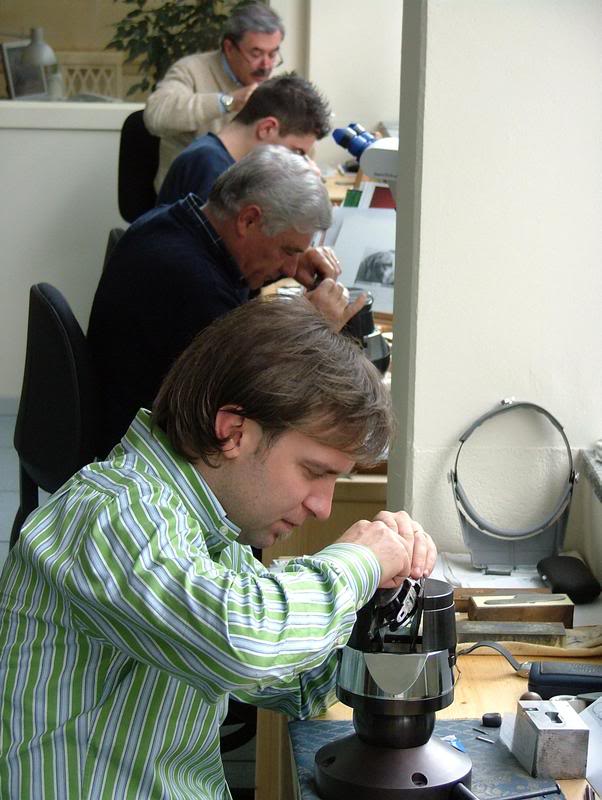 I then went around the corner and up the stairs, to Creative Arts, visiting my friend Giacomo Fausti; the shop was obviously very busy, turning out their usual excellent quality of work. 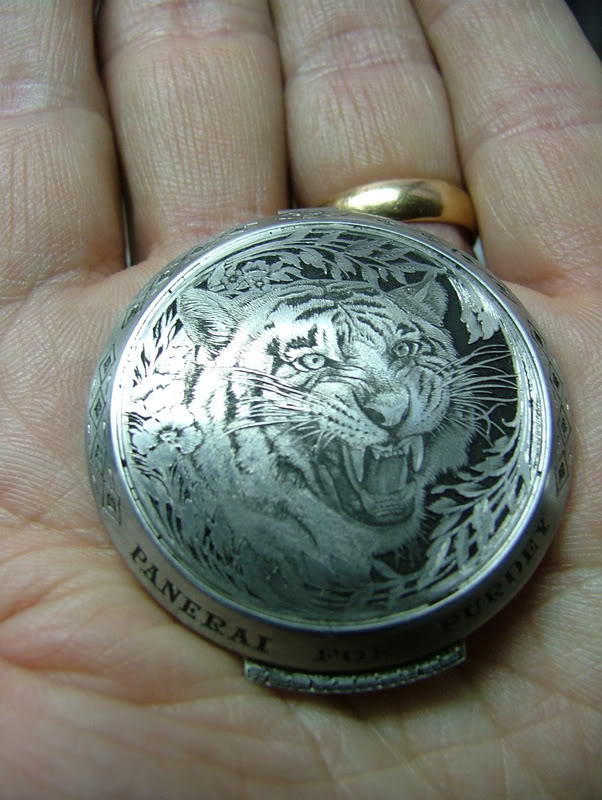 Giacomo suggested we visit Ivano Tanfoglio at the Ferlib Factory, so we crossed the river and headed up the hill, to a gate, we rang the buzzer and walked up to the shop. We entered and found three men at the bench working, a large black dog in the corner, and Ivano in the back machine room busy at the lathe. We knew each other from many meetings at SCI and other shows. Everyone was in good spirits, laughing and grinning. Giacomo headed back to creative arts and Ivano showed me the product line and the production facility. After we had seen some of everything, he said he must visit his actioner, so Ivano and I jumped in the car with the dog and headed to Alta Trompia to the shop of his actioner, It was a tiny place, but very busy, Ivano discussed the job at hand with the foreman as I watched the actioner at the bench work at a furious pace. I have observed this type of work in many shops, and was impressed with this fellow who obviously knew what he was doing. After being taken upstairs to see the cheeses and sausages hanging in the wine room, we headed down the hill, and we agreed to meet the next morning to go back to Ferlib. In the morning Ivano picked me up and we headed to Ferlib where I met their engraver Lepinois Frederique. She was engraving a sidelock with a style of her own we will call lepinois. The design layout had taken her a week, and the work was done entirely in Bulino, and had taken 3 weeks to complete most of the fantastic engraving on the bottom of the action. . Frederique has many books in her library, among the more familiar to me, "Il grande libro delli incisioni"by Marco E. Nobili and "florid Victorian ornament" by klimsch. She also had a set by L'Aventurine press, covering architecture and Iron ornament. As she finished one section, she applied chalk as a base to draw through. After she established her initial pattern she went over it with a scribe, so she could then remove the chalk and begin to engrave, using the small bulino tool, which fit in the palm of her hand. 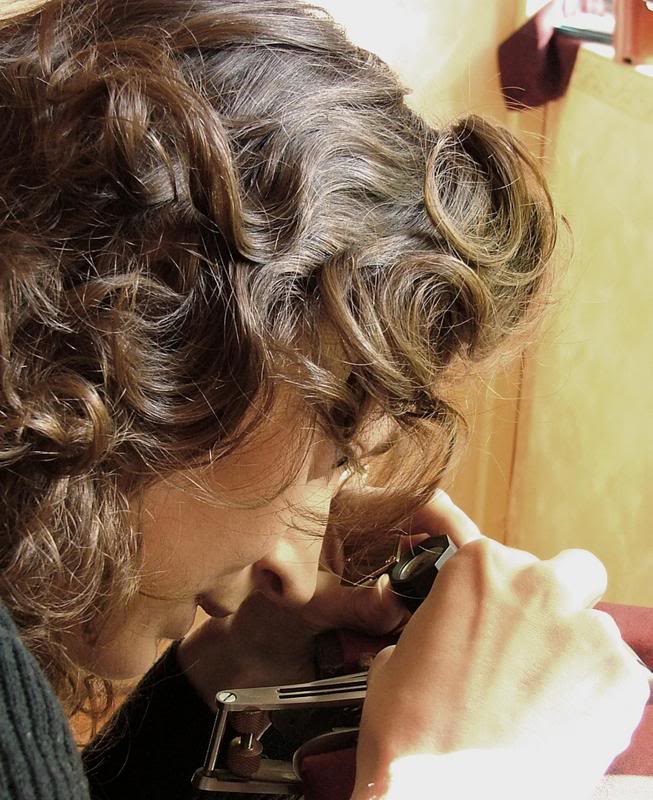 She is truly an excellent in house engraver for Ferlib, which also uses Creative Arts for much of the engraving on their guns. Later in the afternoon we drove to the workshop of Lionello Sabatti, who had with him his friend Alfredo Bregoli. Alfredo and I had met before while he was demonstrating engraving for Stephen Lamboy at SCI. I was doing some consulting and training of engravers for Ithaca at the time. He recognized me and even though he speaks no English we managed to share some laughs. Leonello made espresso and then showed me his bench while he did some engraving on a piece he had in his vise. Leonello Sabatti has his workshop in a beautiful1000 yr old villa with vaulted ceilings. He began engraving when he was fourteen years old and his field of expertise is ornamental scrollwork and game scenes of the old school. In his 60's now, he is one of the most prolific Artists in the trade. 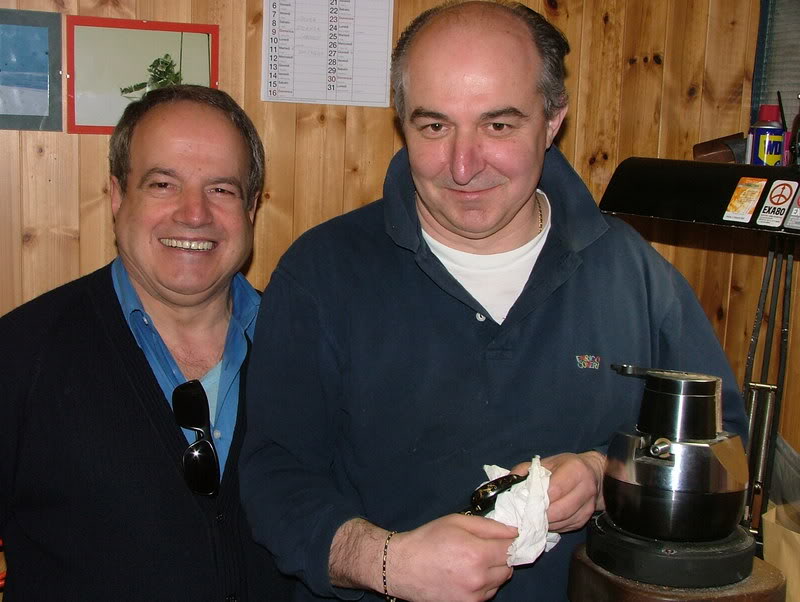 The next day I walked back up to Ferlib. I watched Ivano file fences for an hour or so, and then we headed to the workshop of Manrico Torcoli. When I saw his workroom, I was amazed at how neat and clean it was and how few tools he had. There was a ball vise, two sharpening stones and three gravers. That was it. Period. The room was filled with books on wildlife, and national geographic magazines. We stayed for a bit and Ivano translated as we discussed engraving, engravers and different styles of work. He showed me his portfolios, which contained many fine examples of his work. He is the engraver who invented the style of fantasy which contains animals, blended into lovely nude figures surrounded and mixed with art nouveu motifs. He is one of the rare modern engravers, which have found a style they can truly call their own. All one has to do is to look in the catalogs of major Italian firearms manufacturers to see the many attempts to imitate him. 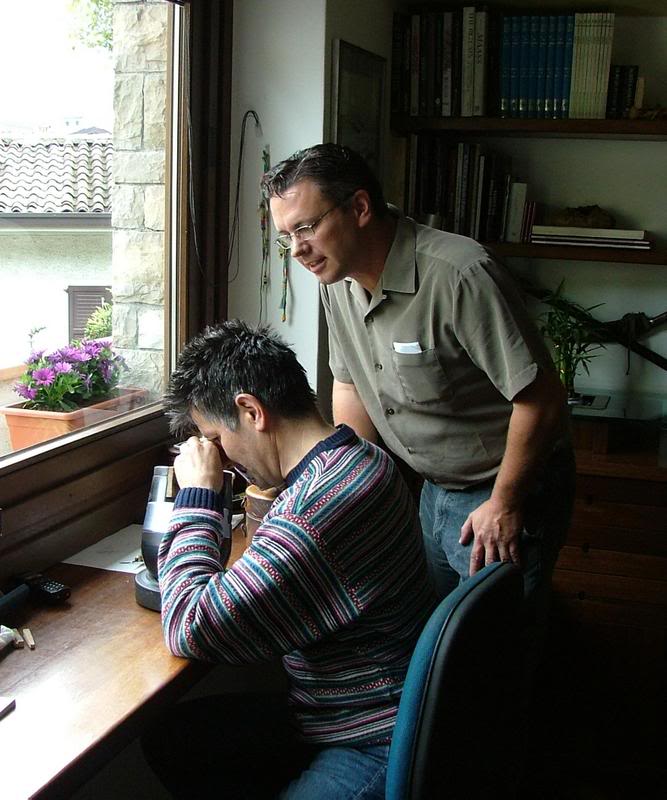 On his bench was one piece, although unmistakably his, which was decorated in a slightly more conventional style containing upland birds and ornament, but still done entirely with the bulino technique. He said he would rather do pure fantasy work, but apparently even he has to follow the whims of the client to some extent. Much of his work is for Fabbri and F.li Rizzini Torcoli suggested we visit Pedersoli later in the day, and we went to lunch at a restaurant in Alta Val Trompia. These midday lunches are extensive meals with a first course, second course, salad bread and wine, followed by espresso with baileys. I understand why the makers and engravers here start so early, each afternoon I felt like falling asleep at about 2 pm. After a bit we jumped in the car and headed to visit Gianfranco Pedersoli. We rang the bell, were buzzed in and were greeted by the Master and his wife. Their home was very inviting, decorated with antiques and the wall was covered with framed prints of rubbings taken from his work. We were ushered into the studio, and I was impressed with the elegant but simple decoration and layout of the room. He demonstrated his techniques at the bench, engraving with a bulino tool so quickly it sounded like he was using a machine, but all the work was by hand. He then demonstrated how he pulls a print, by rubbing ink into the engraving and burnishing a piece of damp paper into the impressions left by the tool. Once the paper is removed it leaves a very nice image of the work that has been accomplished. I think his work, which includes many fantastic figures and scenes, often surrounded with ornament with a baroque feel, influenced many of the younger engravers a great deal. He also does much work for Fabbri and F. li Rizzini as well as Galazan. 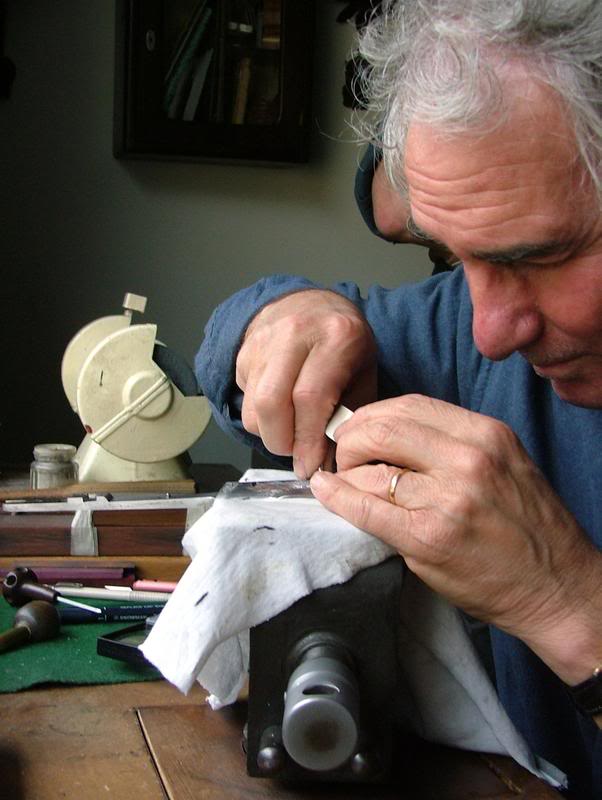 The next morning I walked up to Ferlib, and Ivano said he had several appointments this morning. I told him not to worry about me, that I would call him this afternoon. I only had two more Artists that I felt I needed to meet to make my trip complete. Firmo and Francesca Fracassi... I set out on foot...over the years I have learned I can find anyone or anything on foot. I walked down the valley toward Brescia, passing Armaiolo after Armaiolo, looking for someone who could steer me in the right direction. I came upon Famars. Christina Abbiattico's father had literally written the book on Italian engraving years ago, if anyone knew where to find Fracassi, she did. I went to the office and was greeted by Christina, whom I knew from the many shows that we both attend. I told her I was looking for Fracassi; she told me his home was only a short distance away. I thanked her and headed off, down the street again, address in hand. When Fracassi answered the door he ushered me inside and introduced me to his wife and his smiling daughter Francesca, a charming young lady, who fortunately for me, speaks some English. I offered my card and explained I was visiting from the US and planning to write an article. Firmo nodded head in understanding and Francesca asked if I would stay for lunch, I said I would be delighted if it was not too much trouble, she said" If anyone is here at this time of day, they always stay for lunch". While Mrs. Fracassi went back to preparing lunch in the kitchen, Firmo motioned us upstairs to the studio. It was very typical of what I was becoming familiar with as the Italian Bulino engravers bench, very neat and clean, set below a north facing window, in a tastefully decorated room with art on the walls and many wildlife books on the shelves, except this time there were two engraving balls besides the usual two or three gravers and a couple of sharpening stones. Mr. Fracassi sat at their bench while Francesca sat beside him and acted as interpreter for her Father. I was intrigued looking at the work in the vises, because they had small cardstock covers over the work with a small opening perhaps 5/8 x3/4" through which they worked on a small area. I asked Francesca about this "We use the protection of the card to avoid scratching the areas we are not working on at the moment" She took off the cover and I could see the mostly finished scene, with swans and water and mountains in the distance. It was stunningly well done; even in its unfinished state it gave the illusion of depth and sweep of scope that only a true master of bulino can achieve. Next I asked if they used any transfers or other mechanical or photo techniques to put the initial design on the metal, as so often done in America. Francesca seemed puzzled by this question and discussed it in Italian with her father. “The design is drawn on paper with a pencil and then we draw it on the action with a scribe", her Father picking up a simple machinists scribe from the bench and making drawing motions with it. She then took the work from the vise and handed me the work and a jeweler’s loupe. Looking through the loupe I could see very faint scribe marks in the unfinished areas, which revealed the original drawing on the metal. The most striking thing I noticed were the tiny parallel lines used in the sky and water, the were almost straight with the occasional bump or flutter to indicate movement, they were so tiny and well cut, with no trace of an edge or burr that one expects to see on even the best cut line. And the tiny nicks of the bulino, so small as to appear to be dots, were always laid out in the direction of flow in the scene, with not a single mark out of place, every touch of the bulino tool having a purpose in the scheme of the overall view. Wondering how the cutting was accomplished so cleanly I asked if they did any polishing after the work to remove any burrs or roughness. In America some engravers use fine abrasives to remove the burr, in England in the old days, the work was often burnished lightly with a piece of polished steel to accomplish the same thing. Once again I could see this was an unfamiliar concept to Francesca as she discussed it with her Father, who picked up the piece, sprayed some oil on it, and wiped it clean. She said, "This is all we do when finished, only oil, no polishing or Ink" The precision of the work is truly remarkable. I told Francesca, " Tell your Father I am very impressed with his work" She looked embarrassed and said " This is my work " Now I felt a little stupid as she handed another piece of work, "This is my fathers" she said with a smile. I took the loupe and examined this piece and I could see no discernable stylistic or technical difference with the way the piece was executed, I am not sure, even today, I can tell who is who when looking at their work, unless it is a piece I am familiar with. 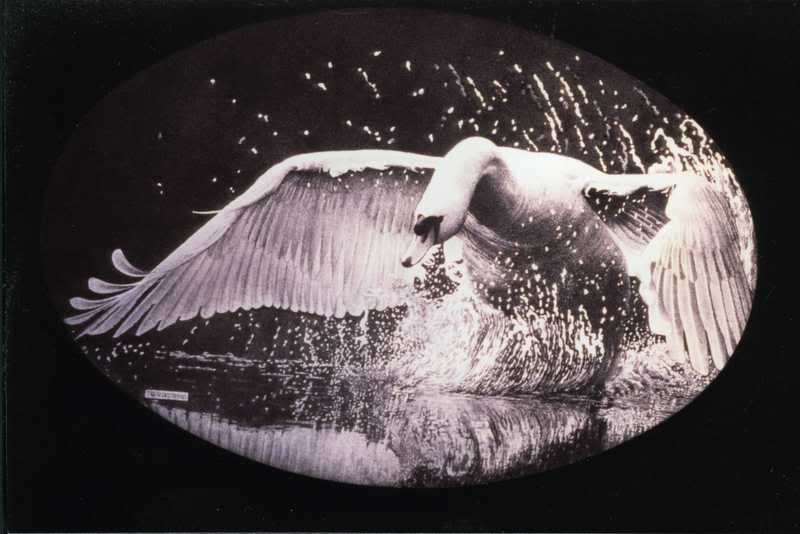 I asked if there was any difference between her work and her fathers, after conferring with him she said" my father has taught me to engrave in his own way" She did say that when they work together on a piece with bulino ornament in their own almost art nouveu style, she often does the ornament while he does the figures. Mrs. Fracassi called us down for lunch; we went downstairs and enjoyed a lovely meal of pasta with bread and wine, followed by cheeses, espresso and a liqueur. During the meal Firmo asked me many questions about my travels, the engraving business in America, and American engravers. I tried to give him as accurate and objective information as I could. He asked about Winston Churchill, saying he had visited 20 years before, from Vermont. After we finished we went back to the studio were they showed me dozens of photos, pointing out who had done this or that, and Francesca picked out some for me to take with me on my travels. Saying our goodbyes, they walked me to the street and I headed back to Ferlib, my head spinning, filled with their graciousness, their art, and new ideas.  I thought it would be difficult to leave the small mountain city where so many of the best guns are made and engraved, but I reflected on what I had learned. These men and women as a whole have no secret techniques, no "tricks". The methods they use were very similar to what I had seen many other engravers practice. If anything, their tools were simpler than those often used in the US. I can only conclude their outstanding work is the result of three things. Talent, knowledge, and hard work. As I walked back up Via Independenza a bur of images and Ideas were in my mind, and for the first time I felt ready to leave this place, I was sure of what I should do next, one thought rose above the others...”I must get back to my bench...."
__________________
Barry Lee Hands www.barryleehands.com "Critics gather, they discuss aesthetics, Artists gather, they discuss turpentine. . ."- Pablo Picasso Last edited by Barry Lee Hands; 03-13-2007 at 01:30 AM. |
|
#2
|
|||
|
|||
|
Barry
Fantastic. Great photos and an excellent read. Inspirationl trip. Thank you very much for sharing that. Really appreciated. Cheers Andrew |
|
#3
|
||||
|
||||
|
Barry,
Extraordinary Beautifull,!! A True Insperation, Only Wish I had Started this Engraving Business Many Winters Before, So Much To Learn !!! So Little Time. Thanks Again. !!! |
|
#4
|
|||
|
|||
|
Excellent post Barry. Reading and seeing such a high level of skill and talent is surely amazing...as well as humbling! As Chris appropriately responded "so much to learn, so little time"!
Thanks, Peter |
|
#5
|
||||
|
||||
 Yes, a very excellent article and post. Thank you Barry. Yes, a very excellent article and post. Thank you Barry.
|
|
#6
|
||||
|
||||
|
Very Impressive - not just the people in Italy, but you also. We had no idea of your background or talent.
They seemed not to know of some things "we" do. Have you demonstrated any of them to them? Next time you visit, are you going to take your PC and show them how easy it is to use? That would be a revelation to them (and a revolution if some adopted it - haha). They all only use "old world" techniques. but the "new" ones may adopt the power tool. I think all engravers are awsome but some are eye wateringly good. That swan is just impressive, and some of the ones by Lindsay and at Engraving Arts look like a B&W photos, Would have liked to have seen some more of the actual work, if you have pics can you post them? ps - How did you first see a PC and then decide to "join the revolution"? |
|
#7
|
|||
|
|||
|
hi Barry .. thanks for your great input into this forum with all of your knowledge and photos of your trips to these engraving schools .. have you ever asked them why they use a small magnifier instead of a microscope you would think a scope would be easier when engraving .. some day before i get too old i would love to go over there and tour the engraving schools .. thanks again ron p.
|
|
#8
|
||||
|
||||
|
WOW Barry
Thanks for the tour it was fantastic I have to get over there just to be amazed of the talent. Like you said I want to get back to the bench 
|
|
#9
|
||||
|
||||
|
Thank you for the comments everyone.
Danny , When I was in Brescia I carried a powerbook, I noticed several Macs in workshops and plenty of other computer stuff used for cadcam design of gunparts, internet and advertising artwork. As to my PC background, I was at Heald college in San Francisco in 1980. One of the instructors had an ARPANET connection. Back then, as I remember it, the Intel 8088 processor was the big thing, At one time I had all of the machine language commands for that processor memorized. Since then I have drifted away from serious electronics. Ron, Except for a few,the Italians did not seem too interested in hi tech engraving equipment. It is like a different planet over there. More Arms are hand engraved in Italy than on the rest of the earth put together. I have not been inside the factory, but I believe Beretta employs the largest number of engravers, and I was told they use hammer and chisel. One needs to take into account the fact that hundreds of engravers are professionally trained inhouse every year in europe, and many fall by the wayside. the ones who stay in the biz are generally the cream of the crop, and can produce excellent engraving with primitive tools at a speed which would cause the heads of most of our fellow american engravers to spin. To do good bulino all a highly trained, skilled engraver with natural aptitude needs is a graver and a stone. When said engraver reaches twentyfive or so, then they need a loupe. To use myself as an example, I did not use any magnification at all until I was about thirty, even though I spent thousands of hours as a bench engraver in the mercenary service of several different firms. When I was first trained at seventeen, I could focus on the work in my block, when it was one half inch from my nose. Arms engraving evolves naturally from two elements: Carbon and Iron. Engraving in historical fact has been influenced more by geology, geography and demography than any thing else. The centers of arms engraving throughout history have followed the centers of production, and the centers of production were usually as close as possible to the capital of the empire in a secure area where there is coal and iron ore. This is why Damascus was a center for the Persian empire, and then the Moslems, and Brescia for various empires since the days of Rome. And there is the example of Liege. And the great american gun companies.This scenario has repeated time and again in many locations as the centers of empire changed. In England it was Birmingham, and the nearby city of London, the cultural center of the upper classes, that had the money of the aristocracy, the empire, in which were the animals to hunt, and the ships to deliver them to the empire. These factors came together to make London the center of the gun engraving world until the collapse of said empire in the post WWII period. The italians have taken over much the high end I believe, partly because of the fact they are two hours by private jet from the oil empires of the Arabian peninsula. It still remains to be seen how deeply the flattening of the earth by the internet, and centralized steel production will effect these geographic realities. Steel is still made from iron ore and coal. Once manufactured, it is expensive to ship, due to its weight. When the shipping problem of raw steel is overcome then one needs a geographic density of skilled workers to manufacture weapons at a reasonable enough price to support the base of a market which creates the environment in which entry level consumers over the years become, or inspire entry level collectors to support, a diverse and healthy collectors' market. Some business planners hope that if they advertise enough, train enough engravers, hire enough Masters, and award a degree in fine arts, they can make a small town in the midwest the center of the engraving world. If they succeed it will be the first time in history the center of engraving has moved away from the earth from which it grew. We can only wish them luck. American workers have often competed with overseas workers by increasing productivity through technology. American Engravers can only benefit by hi tech productivity strategy. My friend Bob Evans once referred to using the best technology and tools as " Skill multiplication". I think that is a great term. Lindsay tools and microscopes can easily fit into that productivity increasing strategy. I hope this partly answers the questions. ![Smile[2]](/images/smilies/top smiles/smile[2].gif)
__________________
Barry Lee Hands www.barryleehands.com "Critics gather, they discuss aesthetics, Artists gather, they discuss turpentine. . ."- Pablo Picasso Last edited by Barry Lee Hands; 03-14-2007 at 01:55 AM. |
|
#10
|
|||
|
|||
|
Well Barry, another piece of really interesting writing I must say.
Thanks for that Andrew |
|
#11
|
||||
|
||||
|
Thanks barry! Great writing and thoughts.
I think I'll just give up now! Or maybe I'll try to work harder! Tom |
|
#12
|
||||
|
||||
|
Barry,
What can you tell us about those ball vices they have over there? I saw several of those engraver's blocks in the photos and I like the way they look and wondered who made them, the availability...
__________________
"If one needs a tool, and does not acquire it, they end up paying for it, but not having it." - Henry Ford |
|
#13
|
||||
|
||||
|
Thank you Barry, a really first-rate write-up and great pictures.
I'm always amused at how often the European craftsmen (not just engraving) look upon the ultra high-tech Americans with all their goodies; they pick up their hand tools and smile inwardly, as they produce incredible work. I think a lot of it is the lack of anything that could be called a true apprenticeship here in the U.S. American kids think "College or nothing"... in Europe, vocational trades and schools are respected branches along the educational path. |
|
#14
|
||||
|
||||
|
Say Barry - I think you mis-construed the PC for the PC. My fault for not clarifying it. PC (on this forum means Palm Control) instead of PC (meaning Personal Computer). :>)
I was just curious if you brought yours (the next time) and let them use something so sophisticated and easy to use, if they'd have a "slight" change of heart. (I didn't think you had a PC (palm control) when you went for the article). |
|
#15
|
|||
|
|||
|
Barry just wanted to know if the engraving on all the recievers was done before heat treat.
|
|
#16
|
|||
|
|||
|
All power to the Italians I say.
I guess it's a case of "if it aint broke, then don't fix it". With the way they learn and execute their art of engraving it has a connection that goes back for generations. I also think that the main thing that is overlooked is the design aspect. We have a tendancy to look at the technique side of things and how to use the tools. If we can master the technique, then we can produce work as good as the masters. No we can't. What makes Fraccassi and Pedersoli's work stand out the most...........not so much their technique (which is amazing) but the designs. The technique is only there to execute the design, not the other way around. The engraving schools from what I have read put a huge amount of emphasis on this side of things. In some cases the student dosn't pick up a graver for months, instead they are taught to draw and design. We overlook that side of things to our own detriment. I work with a microscope because my eyes arn't the best and I don't know any better. However I can see definate advantages working with a loup or optivisor. On certain part of guns, positioning the work under a scope can be a real pain. Having that freedom of head movement would be a real advantage. My guess is that if the Italians started using microscopes, air assist gravers, power hones, palm controls, diamond laps, thermolock and all the rest of the gear we use, the work probabley wouldn't get any better as it's already so good. They put the emphasis on their engraving art where it belongs, the design side of things. The tools are there only to complete the job. Anyway that's my thought for the day Cheers Andrew |
|
#17
|
||||
|
||||
|
I agree Andrew. Design is King.
It is also the hard part! Tom |
|
#18
|
||||
|
||||
|
Andrew
I agree to a point, in the USA we have lost the craft and artist of jobs every one has to go to college to be anything any more a bunch of BS as far as I am concerned. The europeans seem to have kept the apprenticeship system good for them.And I wish the USA still did the same. However as a person who has worked with my hands for over 50 yrs the modern tools like the PC have got rid of ailments such as RMS.If I hand to use push gravers and hammer and chisle the pain would not be worth the pleasure to me ( might be a blessing to the engraving world) The great masters of the past pick any trade, craft ,art IMHO would use any tools that made the work easier. Dave |
|
#19
|
||||
|
||||
|
Yes Danny you are correct, I completely missed "PC" I still have electronics on the brain, hehe. As to your actual question, I am planning to take my PC over to London next week. I just finished sixs months of grueling work , the coffers are full, and I am going to visit my engraving buddies, and meet some more . I may be going to a couple of gun auctions, I will try to get by purdeys' and Hollands', but my main interest is the engravers. I will also try to visit some barrelmakers and wood guys, maybe even visit a pub or two, or three.
I will go to several museums, there is so much over there, and if I can I will get some english hackers along for the ride. I will have a car, so perhaps i will drive over to france for a bit. I would also like to see the london proof house. Andrew I love your positive comments, they really apeal to my vanity( All sin is vanity) And I will think of writing things you can use. An editors road is much harder to travel than a writers, I writer must merely experience the world freely and retain a bit of it, an editor must be a judge of writing, but even more he must be a judge of agenda and motive to pursue an ethical and moral stewardship that is not always so clear to see. There are powerful forces that want things from the guild, be aware. Good Luck my friend. The italians have an advantage in numbers of students, and the geography. They are very close to florence and Rome and al the beauty and good public works that have come before. It is engraving by cultural immersian. Andrew in my work the good desin comes in blinding flashes of momentary inspiration, After Ben Shostle died I swear I was channeling his work for a few months even though I had never followed his style. I cannot tell you where that comes from. it need not take more than a moment... Cheers from the old red...
__________________
Barry Lee Hands www.barryleehands.com "Critics gather, they discuss aesthetics, Artists gather, they discuss turpentine. . ."- Pablo Picasso Last edited by Barry Lee Hands; 03-15-2007 at 11:01 AM. |
|
#20
|
||||
|
||||
|
I agree with the comments - up to a point (at least my point). Design IS KING but the TALENT IS EVERYTHING! There are a great many people who have learned how to engrave (or paint, or draw, or sculpt) who really know the technical aspects and have a modicum of talent. They produce acceptable to pretty good work, but those with talent are the ones that produce really good work, then you add in artistic ability and it goes in to the "eye wateringly good" (outstanding) catagory. One can be learned, and with practice it looks like talent - but it is always just short of 'WOW', and that is where the ARTISTIC TALENT comes in. There are a few who post here, and other places, that are in that catagory, but it seems like Italy has kept most of it. The talented-artistic ones with a natural inclination to engrave are the cream of the crop. It isn't so much the place as the inate ability of the person. There (in that one area it seems) they do more engraving, as that is the most exposure in that area.
Well, back to "hacking" my way through some poor defenseless hunk of metal! Danny |
|
#21
|
||||
|
||||
|
Yes Danny, you are correct.
__________________
Barry Lee Hands www.barryleehands.com "Critics gather, they discuss aesthetics, Artists gather, they discuss turpentine. . ."- Pablo Picasso |
|
#22
|
||||
|
||||
|
Barry, let me add my thanks for a very interesting article. Your insight into the social-economics side of the equation is spot-on. Even in our country's relatively short history, the same mechanisms are true. That's why cars are still built in Detroit. Thanks again for a sharing your experiences.
|
|
#23
|
||||
|
||||
|
I found your article really inspiring. It's so cool they use the most simple tools.
I do my engraving now at my store with the compressor and Lindsay classic. But now I am going to set up a manual work bench at home for practicing my bulino technique at home in the evening with just a push graver as I learned originally. I googled Italian gun engravers and was really inspired by the shallow cut, super fine line approach along with some of the flippant art work themes they dare. A totally graphic approach, not so sculpted looking as American engravers. I didn't realize that there was an American style of engraving till I studied the Italians a bit. Thanks for sharing such a great article. James Roettger |
 |
| Bookmarks |
|
|